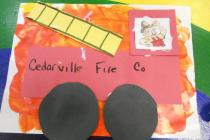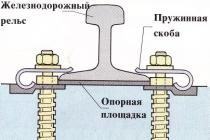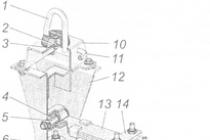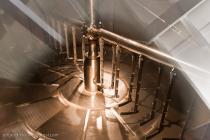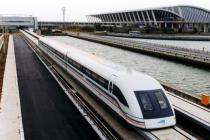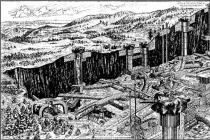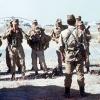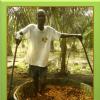Few people know that in fact, in those years, overseas aircraft nevertheless inflicted an unpunished strike on Soviet territory. It happened in the Far East in October 1950 ...
On October 8, 1950 at 4:17 pm local time, two Lockheed F-80C "Shooting Star" ("Meteor") fighters of the US Air Force violated the state border of the USSR and, having deepened almost 100 km, attacked the Soviet military field airfield Sukhaya Rechka 165 km from Vladivostok, in the Khasan region. As a result of the bombardment by US Air Force planes, seven planes of the Soviet squadron were damaged in the parking lot, one was completely destroyed.
That autumn, the war on the Korean Peninsula was already raging. Volleys roared very close to our common state border with the Koreans. In addition, the Americans and their allies did not stand on ceremony with respect to international law. Combat aircraft of the potential enemy made systematic flights near Soviet cities and military bases. Although the USSR did not officially participate in the war, it came to armed clashes.
On the night of June 26, 1950, in international waters, South Korean warships fired at the Plastun cable ship, which was part of the 5th Soviet Navy (now the Pacific Fleet), as a result of which the ship's commander, Lieutenant-Commander Kolesnikov, died. Some of the crew members were injured. The enemy withdrew only after returning fire was opened.
On September 4 of the same year, the crew of the Soviet reconnaissance aircraft A-20ZH "Boston" of Senior Lieutenant Konstantin Korpayev was raised by alarm to observe the actions of an unidentified destroyer, which approached a distance of 26 kilometers to the port of Dalny (formerly Port Arthur). He was accompanied by two of our fighters. On the way to the target, the Soviet planes were immediately attacked by 11 American fighters. As a result of a short air battle, the Boston caught fire and fell into the ocean. All three of its crew members were killed.
This was the military-political background at that time in the Far East. It is not surprising that the units and formations of the Soviet Armed Forces in those parts were in constant tension. Alarms, orders for immediate dispersal followed one after another. On October 7, 1950, this was exactly what came to the 821st Fighter Aviation Regiment of the 190th Fighter Aviation Division, armed with old American piston Kingcobras obtained under Lend-Lease during the Great Patriotic War. The pilots had to urgently fly to the field airfield of the Pacific Fleet Sukhaya Rechka in the Khasansky region of the Primorsky Territory, 100 kilometers from the Soviet-Korean border. By the morning of October 8, all three squadrons of the regiment were already at their new location. Then something almost incredible began.
On Sunday, at 4:17 pm local time, two jet planes suddenly appeared over Sukhaya Rechka. On low level flight, they passed over the airfield, then turned around and opened fire. No one had time to understand anything, as six Soviet aircraft were damaged, and one burned down. There is not a word in the archival documents about whether there were killed and wounded in the 821st Aviation Regiment. But more on that below.
It turned out that the American F-80 "Shooting Star" fighters had stormed the Sukhaya River. The pilots of the 821st Aviation Regiment did not even try to chase the F-80 jet. It would have been impossible on their piston Kingcobras.
On October 9, the USSR submitted an official note of protest to the UN. The government of the Soviet Union was deeply concerned. They could not understand - either this is the beginning of the third world war, or the pilots' mistake.
On October 20, US President Harry Truman, speaking at the UN, pleaded guilty to the United States and expressed regret that the American armed forces were implicated in an incident with a violation of the USSR border and damage to Soviet property. He stated that the regiment commander was dismissed, and the pilots were transferred to a military tribunal, that the attack on the territory of the Soviet Union was "the result of a navigational error and poor calculation" of the pilots. And also - that the commander of the aviation unit, which included the F-80, was removed from his post, disciplinary penalties were imposed on the pilots.
Despite the fact that the incident seemed settled, the 303rd Aviation Division, which had MIG-15 rocket-propelled guns, was immediately relocated from the Moscow region to the Far East. The troops entered combat duty. The situation in the units was alarming.
The Americans continued to defend the version of pilot error until 1990.
"There was a war in Korea. Soviet meteorological data was classified, which deprived us of information about the weather in Siberia and the Far East," recalled Kwonbek, a former CIA and Senate intelligence officer and a former pilot of one of two American fighters that stormed Sukhaya Rechka airfield in 1950. - No identification marks were visible on the ground, radio navigation did not exist ... At an altitude of 3 thousand meters in the clouds I found a hole, we rushed into it and found ourselves above a wide river valley ... knew exactly where we were ... A truck was going west along the dusty road. "
The Americans decided to catch up with the truck and, pursuing the car, went to the airfield. It looked like the Chongjin airfield that the pilots saw on a large-scale map.
“Soviet radars must have tracked us about 100 miles from the border. Following our descent, they probably lost us in the folds of the terrain when we descended into the river valley. A general alert was issued, but the Russians did not have planes or missiles ready to repel an attack. It was Sunday afternoon. There were many planes at the airfield - the dream of any military pilot. In two rows were lined up about 20 aircraft of the R-39 and R-63 types ... On dark green fuselages there were big red stars with a white rim. There was almost no time to make decisions, the fuel was also running out ... I went in from the left, fired several bursts, my partner Allen Diefendorf did like me. "
After making sure that the target was hit, the Meteors turned around and flew away. On departure from the target, the Americans headed for the base and suddenly saw an island near the coast. "Wow," I thought, "Kwonbek recalled." There is no island near Chongjin ... ". Returning, the pilots reported that they had bombed the airfield with planes. Experts checked the aircraft's camera recording, and it turned out that the planes at the airfield were American Kingcobras supplied by the Americans to the Russians under a lend-lease. The camera showed that the planes on the ground did not flare - probably there was no fuel, which means that it was definitely not a military airfield of the North Koreans and the pilots were mistaken.
In the opinion of Lieutenant General Georgy Lobov, who commanded the 64th Aviation Corps at that time, now deceased, and the former pilot of the 821st Aviation Regiment V. Zabelin, there could be no mistake. The Americans should have seen perfectly well where they are flying and what they are bombing. This was a clear provocation. According to Zabelin, “the Americans saw very well where they were going. We flew 100 kilometers from our border with Korea. They knew everything perfectly. It was invented that the young pilots got lost. ”Alton Kwonbek's further track record raises doubts about the mistake. He's very successful. Most likely, the bombing was carried out on purpose, and the incident was a pure provocation from the United States.
However, in any case, this is not the only secret of those events. The archival documents of the Ministry of Defense and the Ministry of Foreign Affairs of the USSR speak only of Soviet aircraft broken and damaged as a result of a sudden attack. And not a word - about human losses.
Of course, seven aircraft is not a great loss for a superpower. There were no casualties. According to the official statement. However, there were, apparently, and they. At least in the list of monuments of the Khasansky district of the Primorsky Territory at number 106 appears "a mass unmarked grave of pilots who died during the repulsion of American bombers in 1950". It also indicates that the grave is located near the village of Perevoznoye, the former territory of the military town of Sukhaya Rechka.
It is strange, of course, that the grave is nameless. It is strange that the military archives are silent about her.
Here and in the Great Patriotic War, the fallen were buried wherever and at random, not caring about the mark on the map. For the seventh decade, search detachments have been wandering around the battlefield. And they will wander for a long time ...
On May 9, 1945, the country of the USSR celebrated the Victory over Nazi Germany. The victory was shared with other countries, such as the United States, which opened the Second Front and supplied us with goods through Land Leasing.
But already in 1946 and 1953 the USA bombed our Far East and Siberia. From the official data of the USSR Ministry of Defense, it is not clear what kind of war it was over the next 7 years. The war was covered up by the "war in Korea". But it was NOT Korea that was bombed, but us.
"According to the Central Archives of the Russian Ministry of Defense, Soviet aviation units in the Korean War lost 335 aircraft and 120 pilots. The 64th Air Fighter Corps, which took part in the Korean War, numbered 26,000 people. According to the corps commander, Lieutenant General G.A. Lobov, our losses in air battles amounted to 335 aircraft and, according to updated data, 200 pilots. "
(See Izvestia, February 9, 1994, and Komsomolskaya Pravda, June 25, 1991.)
Every war has a purpose. Announced and secret.
What was the goal of the UNKNOWN war of 1946-1953. ?
Stalin and Budyonny during the parade stand on the Mausoleum on Red Square near the Kremlin, Moscow.
We live in a fog of myths and lies
Do we know our history? Do we remember the events that happen to us? It is unlikely that a person remembers everything that happened to him in his life. Therefore, it is also impossible to remember historical facts, especially when you are still being led in in the dark, hiding reality in the labyrinths of politics and the struggle for the enslavement of the peoples of the world by a flock of eternally hungry jackals.
We live in one place in our large country, and do not know what is happening at the other end. The country is big, but a person lives only in his own small reality.
Today there is a cold war between Russia and NATO countries, led by the United States. Living and being contemporaries of our life with you, we still do not know what is really happening around us, because many facts are hidden, as if they did not exist and did not exist.
It is no wonder that today we are discovering with you events from the past that are hard to believe. Our grandfathers and parents lived at that time, but they did not tell us everything that we learn from the archives. But these events happened to people. Hundreds of people were witnesses. They were silent? Why? Or all the witnesses to the "inconvenient" events went under liquidation, as was usually done in our society of Soviet reality.
In the 60s of the twentieth century, that is, in 1960 and beyond, uprisings broke out in Russia against state power during the period of the General Secretary of the Party, Nikita Khrushchev. The uprisings were brutally suppressed. Tanks crushed people. They were shot in the squares. If these were small settlements, then, as a rule, entire villages fell under the liquidation. If the whole city expressed dissatisfaction, then it was more difficult here. But, despite these difficulties with gagging a large mass of the population, the military took cities under siege, blocked all exits from the city, and worked through every house, every apartment for information leaks to other cities.
The puncture happened only once. In a big industrial city An uprising broke out in Novocherkassk. People were starving. Salaries were lowered. There was nothing to eat, the shops gaped with empty shelves. Slave labor could not be introduced into the post-war population when the Second World War of 1941-1945 developed among the people the desire to survive at any cost. The hands of the male population still remembered the locks of the automatic rifles. The mentality of the population was still clearly trying to divide into friend or foe.
But there were cases, egregious in their cynicism, when the "truth" did not go beyond the boundaries of hundreds of hectares of land. Because there was practically no one to tell what is difficult to believe today.
For example, few people know that the United States bombed our Far East in the 1950s. Just 30 kilometers from the large city of Vladivostok, US Navy fighter jets bombed five military units.
Our allies in the war against fascism after the end of the war, five years later, unleashed a new war with the USSR, about which practically nothing is known to this day.
In October 1950, four (4) American fighters attacked the Sukhaya Rechka military unit. They bombed completely together with the civilian population around the unit.
Then, day after day, about 11 American fighters flew in from Japanese airfields and bombed our next military targets. Bombed according to official data, which is not fully known to us, 5 military units, 103 military aircraft.
And to this day the world does not know the truth about the war in the Far East on the territory of the USSR. Until now, the truth is prohibited. And only some declassified data reach us, such as an interview with Poltoranin in the Karaulov program.
Our minds are still obscured by false data about real events. The bombing of Siberia and the Far East by the Americans continued for more than one day. And it was not a surprise for us, for the USSR. In the Far East there was a war, which for us was designated as the Korean War.
"There was a war in Korea. Soviet meteorological data were classified, which deprived us of information about the weather in Siberia and the Far East, " - recalled Kwonbek, a former employee of the CIA and the Senate Intelligence Committee, and also a former pilot of one of two American fighters that stormed Sukhaya Rechka airfield in 1950.
The former stormtrooper talks about the weather in Siberia and the Far East, not Korea. In the opinion of Lieutenant General Georgy Lobov, who commanded the 64th Aviation Corps at that time, now deceased, and the former pilot of the 821st Aviation Regiment V. Zabelin, “the Americans saw perfectly where they were flying. We flew 100 kilometers from our border with Korea. "
This is not the only secret of those events. The archival documents of the Ministry of Defense and the Ministry of Foreign Affairs of the USSR speak only of Soviet planes broken and damaged as a result of a sudden attack. And not a word - about human losses.
In the list of monuments in the Khasansky district of Primorsky Krai number 106 is “a mass unmarked grave of pilotskilled while repelling American bombers in 1950 ". It also indicates that the grave is located near the village of Perevoznoye, the former territory of the military town of Sukhaya Rechka.
It is strange, of course, that the grave is nameless. It is strange that the military archives are silent about her. Notice that the planes didn't even take off. They were driven from other regions and destroyed here. What was behind the secrets and betrayal of your people?
Combat aircraft of the potential enemy made systematic flights near Soviet cities and military bases. Although the USSR did not officially participate in the war, it came to armed clashes. But this was rare. Probably, soviet military units had treacherous orders not to return fire. Otherwise how to explain the defeat of 103 combat aircraft at our airfields?
On the night of June 26, 1950
in international waters, South Korean warships fired at the Plastun cable ship, which was part of the 5th Soviet Navy (now the Pacific Fleet), resulting in the death of the ship's commander, Lieutenant-Commander Kolesnikov. Some of the crew members were injured. The enemy withdrew only after returning fire was opened.
September 4, 1950
years to observe the actions of an unidentified destroyer that approached a distance of 26 kilometers to the port Dalny (formerly Port Arthur), [ - now it is the Chinese city of UDALYANCHI]
on alarm, the crew of the Soviet reconnaissance aircraft A-20Zh "Boston" of Senior Lieutenant Konstantin Korpayev was raised into the air. He was accompanied by two of our fighters. On the way to the goal soviet planes were immediately attacked by 11 American fighters
... As a result of a short air battle, the Boston caught fire and fell into the ocean. All three of its crew members were killed.
Units and formations of the Soviet Armed Forces in those parts were in constant tension. Alarms, orders for immediate dispersal followed one after another. October 7, 1950 this is exactly what came to the 821st Fighter Aviation Regiment of the 190th Fighter Aviation Division, armed with old American piston Kingcobras obtained under Lend-Lease during the Great Patriotic War. The pilots had to urgently fly to the field airfield of the Pacific Fleet Sukhaya Rechka in the Khasansky region of the Primorsky Territory, 100 kilometers from the Soviet-Korean border. By the morning of October 8, all three squadrons of the regiment were already at their new location. Then something almost incredible began.
Then something happened that should be called a betrayal of the interests of his people, a betrayal of the peoples of the USSR. How to understand the actions of the General Staff of the Ministry of Defense of the USSR, when THREE combat squadrons of the regiment are urgently transferred and then these squadrons of the 821st air regiment were destroyed by our adversary the United States?
On Sunday October 8, 1950 at 16 hours 17 minutes local time, two jet aircraft suddenly appeared over Sukhaya Rechka. On low level flight, they passed over the airfield, then turned around and opened fire. No one had time to understand anything, as six Soviet aircraft were damaged, and one burned down. There is not a word in the archival documents about whether there were any killed or wounded in the 821st Aviation Regiment.
I believe that not two fighters, but much more, were bombed by military units that had just changed their location. They were driven closer to the border by the Soviet leadership and given up for complete destruction.
October 8, 1950 it was Sunday. Residents of the surrounding villages were resting at the sea, the field airfield Sukhaya Rechka lived on a weekend schedule. For the exercises, Po-2 air spotters and Kingcobra piston fighters were relocated to it. A total of about 20 aircraft, which stood near the runway in a slender line.
From the memories of the stoker:
- - And you know, son, our Americans navigated the irradrome once, in the fifties.
- - What are you, grandfather, there was no war here. In Korea, the Americans fought for sure, but so that they took us and swooped down on us like this - it can't be.
- - Very much indeed. Tuta is not always empty, as it is now, it was... There were planes before the war, and they were in the war after. During the war, they say, even an American bomber sat down here, knocked out. Fighters on the irradrome were propeller-driven, yes, "maize", and when it became too small for jet, then it was abandoned. So, sometimes, the turntables fly from Nezhinka and from Sukhodol in the summer. They will arrive in May, you will see for yourself.
Here are other memories:
Sukhaya Rechka is a toponymic, conventional term. In fact, the airfield was located between the villages of Perevoznaya and the station Kedrovaya, Khasan Territory. Enough from the stadium that behind the school on Perevoznaya, walk 400 meters and the first signs of an airfield will appear.
The characteristic elongated tin plates with round holes on the fences of the houses of the surrounding villages are also echoes of that airfield.
Only on October 2, 1964, when the Cold War broke out around Cuba, the population of the USSR received some information about the Sukhaya River.
American pilots, apparently "remembering allied relations," often flew over the ships and bases of the Pacific Fleet. From the moment of the surrender of Japan until the end of 1950. was recorded 46 incidents involving 63 American aircraft of various types. Sometimes anti-aircraft gunners opened barrage and fighters rose into the air. The first air battle took place in 1945. over the territory of Korea, when four of our "Airacobras" intercepted an American B-29 bomber and, having fired at it, landed at the Hamhyn airfield, where at that time Soviet aviation was based, which had recently ended the war with Japan.
Gradually, with a change in foreign policy, random flights turned into systematic reconnaissance, and the air war broke out in earnest, reaching its climax in the 50s. So in May 1950 over the Chukchi airfield Uelkal an air battle broke out between the American "Mustangs" F-51 and the Soviet La-11, as a result of which the pilot Captain S. Efremov knocked out one "Mustang", but himself, having received damage, barely made it to the airfield.
I was born in Chukotka. My parents came to Chukotka when they were young. But we have never heard anything like that that there were battles over Chukotka.
Is the target of the war Alaska?
According to various sources, the Americans made from 800 to 1000 sorties per day. It was a real war. For what? What goals were pursued? and what happened as a result that we do not know?
Perhaps it was at this time that the Americans conquered Alaska from us, which they now present to us as sold in ancient times. Why did the Americans spend so much money on 800 flights a day? This is a lot of money! There was a war going on. About which we know nothing. What are they hiding from us? What do we not know? What was the war for in the Far East? Why did the Americans bomb our Siberia? Until now, video materials about the bombed cities of Siberia are hidden and destroyed on the Internet.
This day in history:
On October 8, 1950 at 4:17 pm local time, two Lockheed F-80C "Shooting Star" ("Meteor") fighters of the US Air Force violated the state border of the USSR and, having deepened almost 100 km, attacked the Soviet military field airfield Sukhaya Rechka 165 km from Vladivostok, in the Khasan region. As a result of the bombardment by US Air Force planes, seven planes of the Soviet squadron were damaged in the parking lot, one was completely destroyed.
That autumn, the war on the Korean Peninsula was already raging. Volleys roared very close to our common state border with the Koreans. In addition, the Americans and their allies did not stand on ceremony with respect to international law. Combat aircraft of the potential enemy made systematic flights near Soviet cities and military bases. Although the USSR did not officially participate in the war, it came to armed clashes.
On the night of June 26, 1950, in international waters, South Korean warships fired at the Plastun cable ship, which was part of the 5th Soviet Navy (now the Pacific Fleet), as a result of which the ship's commander, Lieutenant-Commander Kolesnikov, died. Some of the crew members were injured. The enemy withdrew only after returning fire was opened.
On September 4 of the same year, the crew of the Soviet reconnaissance aircraft A-20Zh "Boston", senior lieutenant Konstantin Korpayev, was raised by alarm to observe the actions of an unidentified destroyer, which approached at a distance of 26 kilometers to the port of Dalny (formerly Port Arthur). He was accompanied by two of our fighters. On the way to the target, the Soviet planes were immediately attacked by 11 American fighters. As a result of a short air battle, the Boston caught fire and fell into the ocean. All three of its crew members were killed.
This was the military-political background at that time in the Far East. It is not surprising that the units and formations of the Soviet Armed Forces in those parts were in constant tension. Alarms, orders for immediate dispersal followed one after another. On October 7, 1950, this was exactly what came to the 821st Fighter Aviation Regiment of the 190th Fighter Air Division, armed with old American piston Kingcobras obtained under Lend-Lease during the Great Patriotic War. The pilots had to urgently fly to the field airfield of the Pacific Fleet Sukhaya Rechka in the Khasansky region of the Primorsky Territory, 100 kilometers from the Soviet-Korean border. By the morning of October 8, all three squadrons of the regiment were already at their new location. Then something almost incredible began.
On Sunday, at 4:17 pm local time, two jet planes suddenly appeared over Sukhaya Rechka. On low level flight, they passed over the airfield, then turned around and opened fire. No one had time to understand anything, as six Soviet aircraft were damaged, and one burned down. There is not a word in the archival documents about whether there were killed and wounded in the 821st Aviation Regiment. But more on that below.
It turned out that the American F-80 Schuting Star fighters had stormed Sukhaya Rechka. The pilots of the 821st Aviation Regiment did not even try to chase the F-80 jet. It would have been impossible on their piston Kingcobras.
On October 9, the USSR submitted an official note of protest to the UN. The government of the Soviet Union was deeply concerned. They could not understand - either it was the beginning of the third world war, or the pilots' mistake.
On October 20, US President Harry Truman, speaking at the UN, pleaded guilty to the United States and expressed regret that the American armed forces were involved in an incident with a violation of the USSR border and damage to Soviet property. He stated that the regiment commander was dismissed, and the pilots were transferred to a military tribunal, that the attack on the territory of the Soviet Union was "the result of a navigational error and poor calculation" of the pilots. And also - that the commander of the aviation unit, which included the F-80, was removed from office, disciplinary sanctions were imposed on the pilots.
Despite the fact that the incident seemed settled, the 303rd Aviation Division, which had MIG-15 rocket-propelled guns, was immediately relocated from the Moscow region to the Far East. The troops entered combat duty. The situation in the units was alarming.
The Americans continued to defend the version of pilot error until 1990.
"There was a war in Korea. Soviet meteorological data was classified, which deprived us of information about the weather in Siberia and the Far East," recalled Kwonbek, a former CIA and Senate intelligence officer and a former pilot of one of two American fighters that stormed Sukhaya Rechka airfield in 1950. - No identification marks were visible on the ground, radio navigation did not exist ... At an altitude of 3 thousand meters in the clouds I found a hole, we rushed into it and found ourselves above a wide river valley ... knew exactly where we were ... A truck was going west along the dusty road. "
The Americans decided to catch up with the truck and, pursuing the car, went to the airfield. It looked like the Chongjin airfield that the pilots saw on a large-scale map.
"Soviet radars must have tracked us about 100 miles from the border. Following our descent, they probably lost us in the folds of the terrain as we descended into the river valley. A general alert was issued, but the Russians did not have planes or missiles ready to repel an attack. It was Sunday afternoon. There were many planes at the airfield - the dream of any military pilot. In two rows were lined up about 20 aircraft of the R-39 and R-63 types ... On dark green fuselages there were big red stars with a white rim. There was almost no time to make decisions, the fuel was also running out ... I went in from the left, fired several bursts, my partner Allen Diefendorf did as I did. "
After making sure that the target was hit, the Meteors turned around and flew away. On departure from the target, the Americans headed for the base and suddenly saw an island near the coast. "Wow," I thought, "Kwonbek recalled." There is no island near Chongjin ... ". Returning, the pilots reported that they had bombed the airfield with planes. Experts checked the aircraft's camera recording, and it turned out that the planes at the airfield were American Kingcobras supplied by the Americans to the Russians under a lend-lease. The camera showed that the planes on the ground did not flare - probably there was no fuel, which means that it was definitely not a military airfield of the North Koreans and the pilots were mistaken.
In the opinion of Lieutenant General Georgy Lobov, who commanded the 64th Aviation Corps at that time, now deceased, and the former pilot of the 821st Aviation Regiment V. Zabelin, there could be no mistake. The Americans should have seen perfectly well where they are flying and what they are bombing. This was a clear provocation. According to Zabelin, “the Americans saw very well where they were going. We flew 100 kilometers from our border with Korea. They knew everything perfectly. It was invented that the young pilots got lost. ”Alton Kwonbek's further track record raises doubts about the mistake. He's very successful. Most likely, the bombing was carried out on purpose, and the incident was a pure provocation from the United States.
However, in any case, this is not the only secret of those events. The archival documents of the Ministry of Defense and the Ministry of Foreign Affairs of the USSR speak only of Soviet aircraft broken and damaged as a result of a sudden attack. And not a word - about human losses.
Of course, seven aircraft is not a great loss for a superpower. There were no casualties. According to the official statement. However, there were, apparently, and they. At least in the list of monuments of the Khasansky district of the Primorsky Territory at number 106 appears "a mass unmarked grave of pilots who died during the repulsion of American bombers in 1950". It also indicates that the grave is located near the village of Perevoznoye, the former territory of the military town of Sukhaya Rechka.
It is strange, of course, that the grave is nameless. It is strange that the military archives are silent about her.
In our country and in the Great Patriotic War, the fallen were buried anywhere and at random, without caring about the mark on the map. For the seventh decade, search detachments have been wandering around the battlefield. And they will wander for a long time ...
And how many have heard about it ...
In the Far East, in the Khasansky district of the Primorsky Territory, there is the village of Perevoznoye. The Sukhaya Rechka military airfield was located a kilometer away from this village. Few people know that several decades ago it was bombed with impunity by American pilots. This attack on Soviet territory occurred on October 8, 1950 ...
* * *October 8, 1950 at 4:17 pm By local time, two Lockheed F-80C "Shooting Star" ("Meteor") US Air Force fighters violated the state border of the USSR and, going deeper by almost 100 km, attacked the Soviet military field Sukhaya Rechka airfield 165 km from Vladivostok, in the Khasan region. As a result of the bombardment by US Air Force planes, seven planes of the Soviet squadron were damaged in the parking lot, one was completely destroyed.
That autumn, the war on the Korean Peninsula was already raging. Volleys roared very close to our common state border with the Koreans. In addition, the Americans and their allies did not stand on ceremony with respect to international law. Combat aircraft of the potential enemy made systematic flights near Soviet cities and military bases. Although the USSR did not officially participate in the war, it came to armed clashes.
This was the military-political background at that time in the Far East. It is not surprising that the units and formations of the Soviet Armed Forces in those parts were in constant tension. Alarms, orders for immediate dispersal followed one after another. On October 7, 1950, this was exactly what came to the 821st Fighter Aviation Regiment of the 190th Fighter Aviation Division, armed with old American piston Kingcobras obtained under Lend-Lease during the Great Patriotic War. The pilots had to urgently fly to the field airfield of the Pacific Fleet Sukhaya Rechka in the Khasansky region of the Primorsky Territory, 100 kilometers from the Soviet-Korean border. By the morning of October 8, all three squadrons of the regiment were already at their new location. Then something almost incredible began.
On Sunday, at 4:17 pm local time, two American jet aircraft suddenly appeared over Sukhaya Rechka. The Americans, who are barely visible from the ground - they were walking high enough - suddenly descend sharply, literally at low level flight they lay a bend over the airfield, open fire and drop four bombs.
One Soviet plane explodes. Another turn - and "Meteora" start firing from machine guns. Seven more of our cars were hit. Having shot all the ammunition within a few minutes, the Americans calmly fly away. There was no chase: it was pointless to chase the jet Meteors on the remaining unharmed Po-2 maize or piston Kingcobras. Half of our 20 planes survived.
“It was a day off. Everyone was relaxing at sea, and then they arrived. They circled, fired machine guns at the planes and disappeared behind the hills. I was already 13 years old then, ”recalled Grigory Boldusov, a resident of the village of Sukhaya Rechka, who still lives there.

It is very important that for several decades both American pilots who participated in the air raid on the USSR, wingman Allen Diefendorf and host Alton Kwonbeck, in their defense, insisted that they had lost their course due to bad weather and shot the airfield by mistake.
The weather, as already mentioned, was wonderful that day. On the fuselages of Soviet aircraft, characteristic marks were clearly visible, which had nothing to do with the "plumage" of Korean fighters. The Americans knew perfectly well who they were bombing. By the way, Kwonbek was already working for the CIA in those years. Subsequently, after retiring from aviation, he worked on the Senate Intelligence Committee. “The Russians did not have ready aircraft or missiles to repel our attack. It was Sunday afternoon. It was like Pearl Harbor for them, ”Kwonbek wrote cynically in his memoirs.
Lieutenant General Lobov, the commander of the 64th Aviation Corps at that time, is sent a report on the dead - the Americans killed almost a quarter of the people who remained at the airfield that day. Several officers went on leave - this saved their lives. And some of the officers were visited by girlfriends from the neighboring Slavyanka - they were later taken to be buried in the regional center.
The report on the dead was sent to Moscow, the night of October 9 falls. A long night, during which no one slept at the airfield. Everyone was waiting for the next raid. The next morning, without receiving any directives from the capital, General Lobov announces an order: to consider the air strike as the beginning of the Third World War. Bring all units to full combat readiness. Why did the general give such an order without waiting for directives from Moscow? Perhaps he just lost his nerves, it turned out that the raid was not the first attack of the Americans. Just few people knew about it then.
On October 9, the USSR submitted an official note of protest to the UN. The government of the Soviet Union was deeply concerned. They could not understand - either it was the beginning of the third world war, or the pilots' mistake.
On October 20, US President Harry Truman, speaking at the UN, pleaded guilty to the United States and expressed regret that the American armed forces were implicated in an incident with a violation of the USSR border and damage to Soviet property. He stated that the regiment commander was dismissed, and the pilots were transferred to a military tribunal, that the attack on the territory of the Soviet Union was "the result of a navigational error and poor calculation" of the pilots. And also - that the commander of the aviation unit, which included the F-80, was removed from office, disciplinary sanctions were imposed on the pilots.
Despite the fact that the incident seemed settled, the 303rd Aviation Division, which had MIG-15 rocket-propelled guns, was immediately relocated from the Moscow region to the Far East. The troops entered combat duty. The situation in the units was alarming. Everything was ready for the outbreak of World War III ...
Of course, the Americans carefully prepared an air strike on the USSR for several months. To do this, several of the newest jet "Lockheeds" were transferred from Japan to the South Korean base of Daegu - earlier, only piston F-51s were located at the base. Initially, four crews were supposed to bomb the Soviet village, but on the morning of October 8, two Meteors unexpectedly showed breakdowns. And the mechanics, who had studied these machines well, did not have time to bring them to the base. Two pilots had to fly - Kwonbek and Diefendorf ...

The Americans continued to defend the version of pilot error until 1990.
In the opinion of Lieutenant General Georgy Lobov, who commanded the 64th Aviation Corps at that time, and V. Zabelin, a former pilot of the 821st Aviation Regiment, there could be no mistake. The Americans should have seen perfectly well where they are flying and what they are bombing. This was a clear provocation. According to Zabelin, “the Americans saw very well where they were going. We flew 100 kilometers from our border with Korea. They knew everything perfectly. It was invented that the young pilots got lost. " Most likely, the bombing was carried out on purpose, and the incident was a pure provocation by the United States.
However, in any case, this is not the only secret of those events. The archival documents of the Ministry of Defense and the Ministry of Foreign Affairs of the USSR speak only of Soviet aircraft broken and damaged as a result of a sudden attack. And not a word - about human losses.
“After this incident, the 64th Aviation Corps was urgently created and preparations began for rearmament,” recalled Nikolai Zabelin, pilot of the 821st regiment. - After the attack, combat duty was also introduced in the regiments. This has not happened since the end of World War II. We sat from dawn to dawn in the cabins and around. There was a feeling of an imminent war ... "
In the list of monuments of the Khasansky district of Primorsky Krai, number 106 is "a common unmarked grave of pilots who died in the repulsion of American bombers in 1950". It also indicates that the grave is located near the village of Perevoznoye, the former territory of the military town of Sukhaya Rechka.
It is strange, of course, that the grave is unmarked. It is strange that the military archives are silent about her. In our country and in the Great Patriotic War, the fallen were buried anywhere and at random, without caring about the mark on the map. Then they said that there were allegedly no casualties during this bombing - only military equipment suffered. But no one can say for sure how many victims are in the grave. Someone says -10 people, and someone - more than two dozen.
In a report, secret for half a century, addressed to the commander of the 64th Aviation Corps, Lieutenant General Georgy Lobov, 27 people died as a result of the same airstrike. Residents of Perevoznoye say that not everyone was buried in a mass grave at that time - the bodies of several civilian employees were taken to the regional center, to Slavyanka.
Today, several dozen people live in the village of Perevoznoye. In the cemetery, where the victims of the American air raid were laid to rest, the graves are more or less well-groomed - a few residents still keep the memory of the victims.
Lockheed F-80
October 8, 1950 at 4:17 pm local time two US Air Force fighters Lockheed F-80C"Shooting Star" ("Meteor") violated the state border of the USSR and, having deepened almost 100 km, attacked a Soviet military field airfield Sukhaya River, 165 km from Vladivostok, in the Khasan region. As a result of the bombardment by US Air Force planes, seven planes of the Soviet squadron were damaged in the parking lot, one was completely destroyed.
American eyewitnesses recall
However, a resident of Vladivostok Vladimir Mikhailov found such a person. This is a direct participant in the attack - an American pilot Alton Kwonback, who, after 22 years in the Air Force, served on the Senate Intelligence Committee and the CIA, has retired and is now farming on his farm in Middelburg.
Kwonbek said that another pilot - Allen Diefendorf, having served 33 years in the Air Force, died in 1996. According to Kwonbek, the shot at the Russian airfield is a victim of a mistake. Low clouds and unexpectedly strong winds caused the planes to be blown to the northeast and damaged the airfield in the port of Chongjin (DPRK), which was not previously planned by the American leadership, but the Soviet one - Sukhaya Rechka.
« There was a war in Korea. Soviet meteorological data were classified, which deprived us of information about the weather in Siberia and the Far East- Kwonbek recalled. - There were no identification marks on the ground, radio navigation did not exist. Calculations were made only on the basis of the direction and strength of the wind, and the flight time to the target determined the need for a descent. The flight took place over the clouds at an altitude of over 11 thousand meters. At an altitude of 3 thousand meters in the clouds, I found a hole, we rushed into it and found ourselves above a wide river valley ... I did not know exactly where we were ... A truck was walking along the dusty road to the west».
The Americans decided to catch up with the truck and, pursuing the car, went to the airfield. It looked like the Chongjin airfield that the pilots saw on a large-scale map.
Blogspot.com
« Soviet radars must have tracked us about 100 miles from the border. Following our descent, they probably lost us in the folds of the terrain as we descended into the river valley. A general alert was issued, but the Russians had no aircraft or missiles ready to repel the attack. It was Sunday afternoon. There were many planes at the airfield - the dream of any military pilot. About 20 R-39 and R-63 aircraft were lined up in two rows ... On the dark green fuselages were large red stars with a white rim. There was almost no time to make decisions, the fuel was also running out ... I entered from the left, fired several bursts, my partner Allen Diefendorf did as I did". Having made sure that the target was hit, the Meteors turned and flew away. On departure from the target, the Americans headed for the base and suddenly saw an island near the coast. " Wow, I thought- Kwonbek recalled. - There is no island near Chongjin ...».
A little worried and consulted a map, the Americans decided that they had struck another North Korean airfield. Returning, the pilots reported that they had bombed the airfield with planes. Experts checked the aircraft's camera recording, and it turned out that the planes at the airfield were American Kingcobras, supplied by the Americans to the Russians under a lend-lease. The camera showed that the planes on the ground did not flare - probably there was no fuel, which means that it was definitely not a military airfield of the North Koreans and the pilots were mistaken.
The very next day, October 9, USSR Foreign Minister Gromyko made an official protest at the UN. In a note of protest, the incident was called "a treacherous violation of Soviet borders", a "provocative act." The USSR demanded that the perpetrators be punished.
For a week in the Kremlin they racked their brains: what is this - the beginning of the third world war, intimidation or really a mistake? 11 days later, President Truman made an appeal to the UN in which he pleaded guilty to the United States and stated that “The US government wishes to publicly express regret that the US military is complicit in this violation of the Soviet border” and that the US government is “ready to provide means to compensate for any damage caused to Soviet property. " He also said that the commander of the US Air Force regiment in the Far East was relieved of his post, disciplinary measures were taken in relation to the pilots: American pilots were brought before a military tribunal, suspended from hostilities and transferred to other units.
Russian eyewitnesses recall
In the summer of 1950, the Korean War broke out between the North and South. The South was supported by the UN forces led by the Americans, while the Russians and the Chinese were on the side of the North.
Blogspot.com
In late 1950, the Americans replaced all of their F-51s with Lockheed F-80Cs, which became the main fighter-bombers of the US Air Force in Korea. From September 28 to October 1, 1950, F-80s flew from Japan to the South Korean Daegu airbase. The 49th FBG (Fighter Bomber Squadron) became the first unit on the Korean peninsula to be fully armed with jet fighters. In November, this group fought as part of the temporary 6149th tactical support wing, which was specially created on September 5. Her motto was "Protect and revenge."
On November 8, four single-seat F-80s, each equipped with six 12.7 mm machine guns and 1,800 rounds of ammunition, 2 bombs and 10 missiles, flew from the Daegu base to the north ...
Blogspot.com
« It was a day off. Everyone was relaxing at sea, and then they arrived. They circled, fired machine guns at the planes and disappeared behind the hills. Then I was already 13 years old", - recalled a resident of the village of Sukhaya Rechka Grigory Boldusov, who still lives there.
At the end of 1950, in connection with the Korean War, exercises began to be carried out in Primorye with the redeployment of units to field airfields. The Sukhaya Rechka field airfield belonged to the Pacific Fleet aviation. There were already Po-2 spotters of a separate air squadron, intended for air cover and adjusting the fire of 130 mm naval tower batteries of the Khasan sector of coastal defense. According to the exercise plan, the Kingcobra of the 821st Fighter Aviation Regiment of the 190th Fighter Aviation Division arrived here for temporary deployment. All planes were parked in open parking along the runway, lined up in a line, which was subjected to an assault by the Americans.
Blogspot.com
At the time of the attack of the airfield, the regiment commander, Colonel IN AND. Savelieva was not at the airfield, he was in the ground forces with the chief of staff of the air corps, to organize interaction during the exercise. Instead, the deputy commander of the regiment, Lieutenant Colonel N.S. Vinogradov, who, instead of giving a signal to take off to the duty officer of the 1st aero squadron, dropped the pilots from the planes.
Colonel Savelyev and Lieutenant Colonel Vinogradov were put on trial and demoted by a court of officer's honor for "poor education of the regiment's personnel."
« After two American Meteors flew in and bombed our regiment on the banks of the Sukhaya River, our leadership took action. Immediately came the 303rd Aviation Division, which was already flying jet "MIGs" in the Moscow region. And after this incident, the 64th Aviation Corps was urgently created and began to prepare for rearmament., - recalled the pilot of the 821st regiment Nikolay Zabelin... - P after the attack, combat duty was also introduced in the regiments. This has not happened since the end of World War II. We sat from dawn to dawn in the cabins and around. There was a feeling of an imminent war ...».

